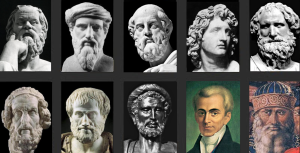Architect (4th century BC)
Pytheos of Halicarnassus, also known as Pythius of Priene, was the architect who, together with Satyros constructed the Mausoleum of Halicarnassus, one of the Seven Wonders of the Ancient World. The megastructure was built as a tomb to house the body of Mausolos, a satrap of Persia. Its name became synonymous to any large funeral monument used today as a tomb.
Almost nothing is known about Pytheos aside from some of the temples he constructed. By far the most famous one if the Mausoleum of Halicarnassus, built between 355 and 350 BC. The whole structure was built on a base podium, on top of which was placed the crypt, surrounded by the temple, which had 36 Ionian rhythm columns around it. The roof consisted of a climactic pyramid of 24 steps, on top of which Pytheos placed a giant statue of Mausolos riding a chariot with 4 horses. The podium’s steps were decorated with scenery from the Titanomachy, Amazonomachy and Centauromachy while the outside of the crypt was decorated with sculptures of the best sculptors of the world, namely Leocharis, Bryaxis, Scopas, Timotheus and Praxiteles. At a height of 55 meters, the Mausoleum of Halicarnassus became one of the most magnificent structures of the ancient Greek spirit.
Pytheos also constructed other temples. The Temple of Artemis Cybele in Sardes, which bears similarities to the Temple of Artemis in Ephesus was designed and constructed by Pytheos as a replacement of the one destroyed in 497 BC. In addition, he designed the Temple of Athena Polias in Priene, which was ordered by Alexander the Great.
His architectural works were described in detail in a series of books that he wrote called Scholia. These books, which today have not survived, were some of the most important sources of ancient Greek architecture, on which Vitrivius also based his description.
Today, almost nothing remains of the wondorous mausoleum or any of Pytheus’ monuments, but rubbles, stones and pillars, a reminiscent of what used to be one of the greatest architectural masterpieces ever built by the Greeks, the ones who perfected architectural science.
Bibliography:
- Georgakopoulos, Konstantinos. Ancient Greek Scientists. Georgiades: Athens, 1996. Print.
- Cartwright, Mark. “Mausoleum at Halicarnassus.” Ancient History Encyclopedia. Ancient History Encyclopedia, 26 Jul 2018. Web. 27 May 2019.

[…] https://greatestgreeks.wordpress.com/2019/05/27/pytheos-of-halicarnassus/ — Read on greatestgreeks.wordpress.com/2019/05/27/pytheos-of-halicarnassus/ […]
LikeLike